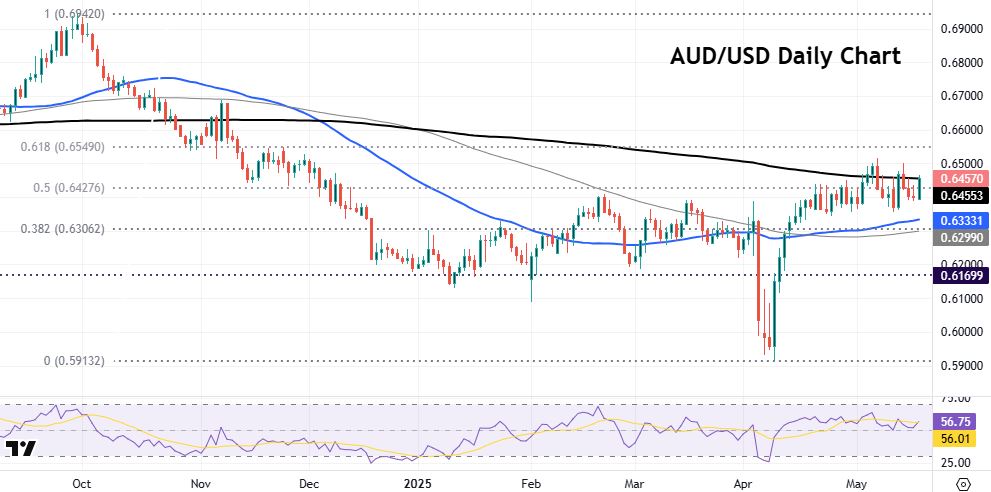Choppy markets shake off Moody’s US downgrade

- Trump says Russia and Ukraine to start “immediate” talks on ceasefire
- UK-EU deal no gamechanger for Britain’s economy and public finances
- RBA tipped to cut rates amid growing confidence inflation is being tamed
- “Sell America” trade sees USD lower, but stocks pare losses
FX: USD fell over 0.6% to kick off the week after the late Friday news about the Moody’s downgrade to the US sovereign rating. The ratings agency warned of a worsening public debt outlook and Republican plans to extend tax cuts. The market impact should be limited, but the credit event serves as further evidence of the dire US fiscal outlook and the lack of political willingness in Washington to address it.
EUR benefited from USD outflows as prices rose but eventually traded back at 1.1243. News and questions around US fiscal sustainability have recently benefitted the single currency, as an alternative highly liquid currency. Dovish ECB chatter didn’t put buyers off, with talk of rates going needing to go below 2%. An internal EU disagreement seems to mean any kind of EU-US trade deal is a long way off.
GBP posted highs above 1.34 before paring some gains. The EU and UK agreed an outline of a deal, in a “reset” of post-Brexit relations. Bulls are eyeing up the highs around 1.3434 with important CPI data released on Wednesday.
USD/JPY fell for a fifth straight day on muted risk sentiment. Japan is said to be holding out for a better trade deal with the US, including full removal of the 25% tariff.
AUD outperformed but remains stuck in a range. The RBA is in focus today. See below for more detail. CAD turned lower but the loonie underperformed versus its major peers. Resistance is the 200-day SMA at 1.4013. Canada headline CPI is expected to slow to 1.7% but the important core measures are seen edging higher to 2.95%.
US stocks: The S&P 500 gained 0.09% to settle at 5,964. The tech-dominated Nasdaq finished up 0.09% at 21,447. The Dow closed 0.32% higher at 42,792. Defensives were again in favour with healthcare, consumer staples, industrials and materials leading the gainers. Energy tumbled 1.55% with consumer discretionary and tech the other sectors in the red. The conclusion of the Trump/Putin phone call saw pressure in the crude oil space, with talks between Ukraine and Russia set to begin immediately. China issued a statement on the US adjusting chip export controls, saying the US is undermining the consensus reached in the Geneva talks and has asked the US to correct any wrongdoings.
Asian stocks: Futures are mixed. Asian markets traded lower after the Moody’s downgrade of the US sovereign credit rating. The Hang Seng and Shanghai Composite were muted following mixed data in which industrial output beat, but retail sales missed their estimate. The Nikkei 225 pulled further back under the 200-day SMA, currently at 37,843. BoJ Deputy Governor Uchida stuck to the script in which he maintained the rate hike signal should prices improve as forecast. The ASX 200 fell though outperformed other regional indices with eyes on the RBA meeting.
Gold was bid on haven demand after the US Moody’s credit downgrade. The dollar sold off while bond yields pared their initial gains and settled lower on the day. Bullion has found support at the 50-day SMA at $3,168.
Day Ahead – RBA Meeting
The RBA is expected to cut rates at its policy meeting today by 25bps taking the cash rate to 3.85%. The bank cut 25bps in February, held in March, and this would only be the second cut of the cycle. Key will be the RBA’s assessment of the risks around tariffs. There may be minor downgrades to GDP, but CPI will remain relatively steady.
At its last meeting, the RBA noted that the outlook remains uncertain and underlying inflation is moderating but there are risks on both sides. Data has been mixed with core inflation readings now within the 2–3% headline target range on a quarterly basis, but toward the top end and with their year-over-year rates still at or close to 3%. The RBA’s fear is easing prematurely and then letting loose renewed inflation risk. The job market has been strong recently with 125k jobs created in the past two months while wage growth remains high. The flip side has been contractions in household spending and building approvals.
Chart of the Day –AUD/USD still tracking sideways
The aussie is often beholden to China news on tariffs and the broader external economic environment – hence why it is often known as a cyclical, high-beta currency. Prices in the major have been trading in a range, between 0.6350 and 0.65, give or take, since the rebound from the tariff chaos in early April. The 200-day SMA at 0.6455 has capped the upside so far. An upside breakout see next resistance at 0.6549. Support is the 50-day SMA at 0.6332 and the major Fib level (38.2%) of the October-April drop at 0.6306.

